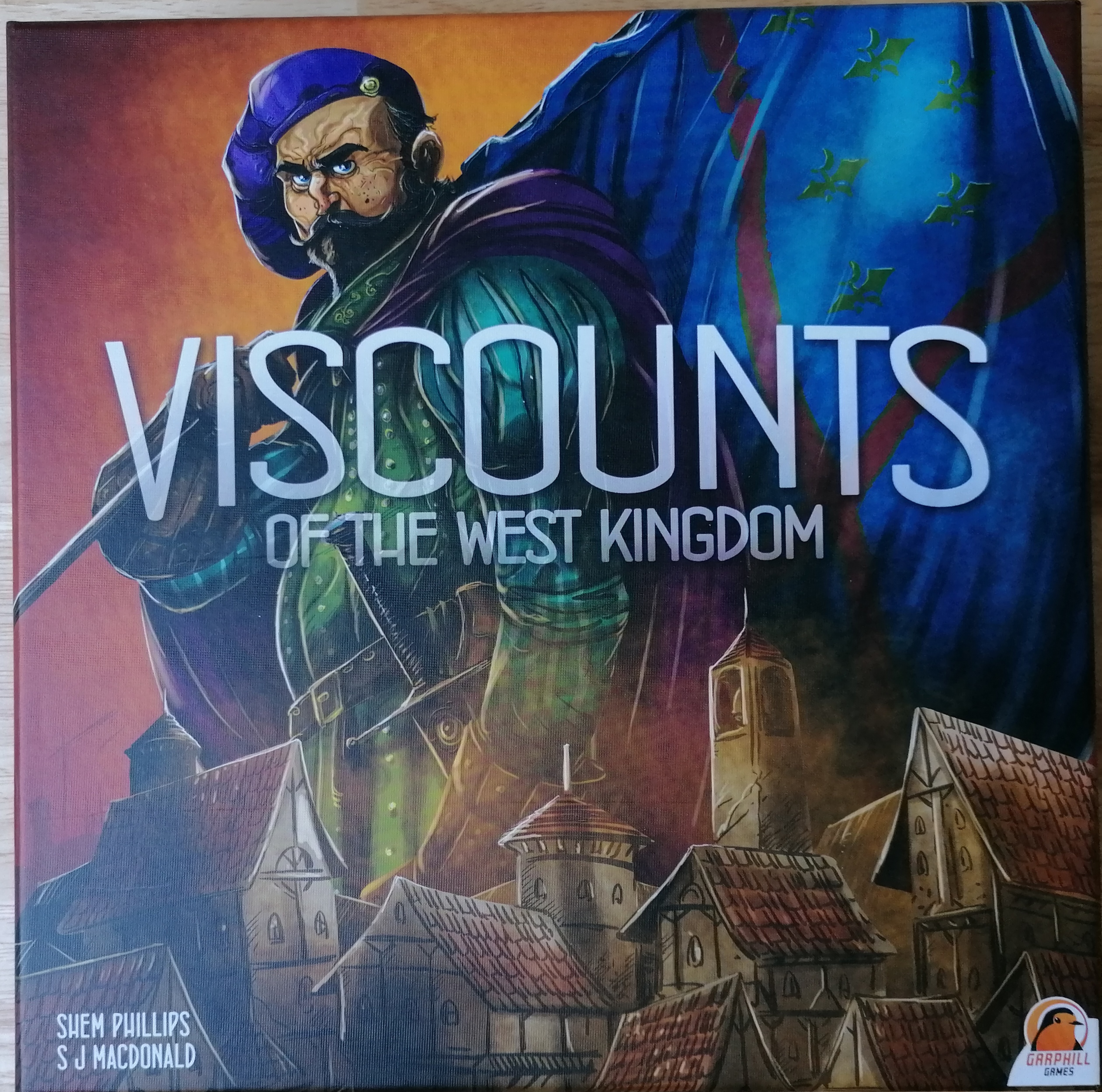Viscounts of the West Kingdom was perhaps the one in the trilogy that excited me the most. As with the previous two, this is a game that puts mechanisms above everything else. Deckbuilding is included as one part of the game, and though I’m quite familiar with this being in games, I don’t tend to gravitate towards it. It’s mainly because, in a lot of games I’ve played with this in, though the concept is good on paper, in practice it’s seemed fairly basic, and therefore not very interesting to me. Viscounts of the West Kingdom, in my opinion, uses it in a seemingly unique way, and so seeing that this game would do something different peeked my curiosity.
The setting carries over from the first two games, though again a number of years later. You’ve built the city, you’ve defended it from invaders, and now you’re battling to gain power, alongside the favour of the people. I would argue that the theme in this third instalment is the strongest of the trilogy, and though theme isn’t my primary concern when it comes to games, I like the fact that these games are all connected. Despite the fact that none of them can be called thematic games, it feels like one continuous story, and I think that adds to the appeal of these games.
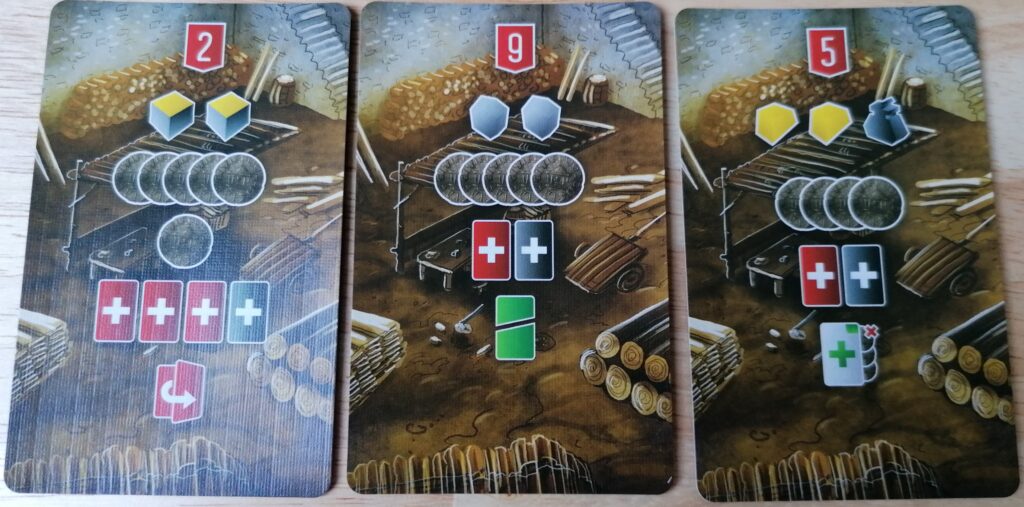
At the beginning of a game of Viscounts of the West Kingdom, players draft two cards, which are paired together. One of these cards is a hero card, which will go into your deck, giving you a small feeling of asymmetry from the start of the game. The other will determine your starting resources, as well as your position on the board. At first glance, the board could look fairly overwhelming, but once you have a faint idea of how to play the game, it will become clear, and it is very well done in terms of usability.
Something I really enjoy about a game is when a player’s turn is simple, but has a lot of depth to it, and it is no different here. I also like when a player has an easy reference as to how their turn will play out, which is shown at the top of your player boards. Again, to someone just coming into the game, and never having played the previous two games, the symbols may not be instantly obvious, but like with the main board, you’ll quickly come to understand them.
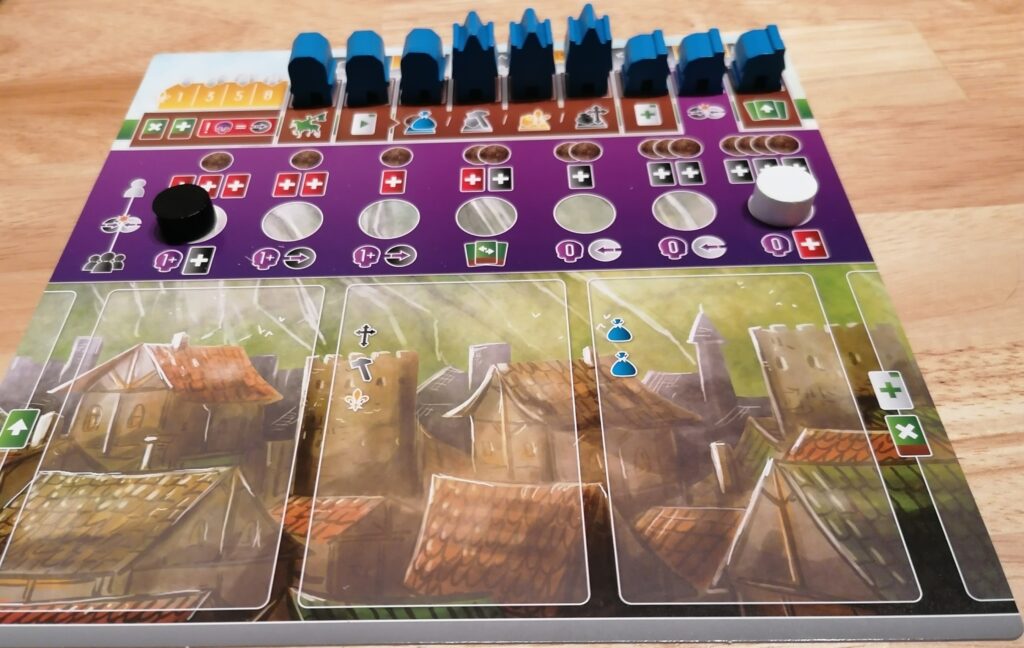
Each turn, you’ll play a card from your hand of three into the tableau on your player board. There are three slots, which hold a card each, and for the first three turns you will fill these up, moving the card on the left-most slot one to the right before playing another card. On your fourth turn, the right-most card will fall off the right-hand side of the board, creating a discard pile. When you play a card, there will be three parts you are looking at: the coin value in the top-left, the symbols just below that, and any symbols along the bottom of the card. The coin value represents the minimum distance you will move your piece on the main board, following the arrows printed next to each space. The symbols just underneath represent how many ‘action points’ you have for the action associated with those symbols. Finally, the symbols along the bottom (if any) will either give you an immediate benefit, an ongoing benefit (for as long as they are in the three-card tableau) or a benefit for when they fall into the discard pile.
After you have played a card and moved your piece, you can choose to dismiss a card face-up on the section in which you have landed, in order to gain their action points, as well as a bonus (shown in the top-right of these cards). Then you will perform your action, choose if you want to hire a card from the face-up deck, placing it in your discard pile, check for a ‘collision’ (and resolve if necessary), and then draw back up to three cards in hand. So as I said, simple, in that all you’re doing is playing a card, but you have so much to think about.
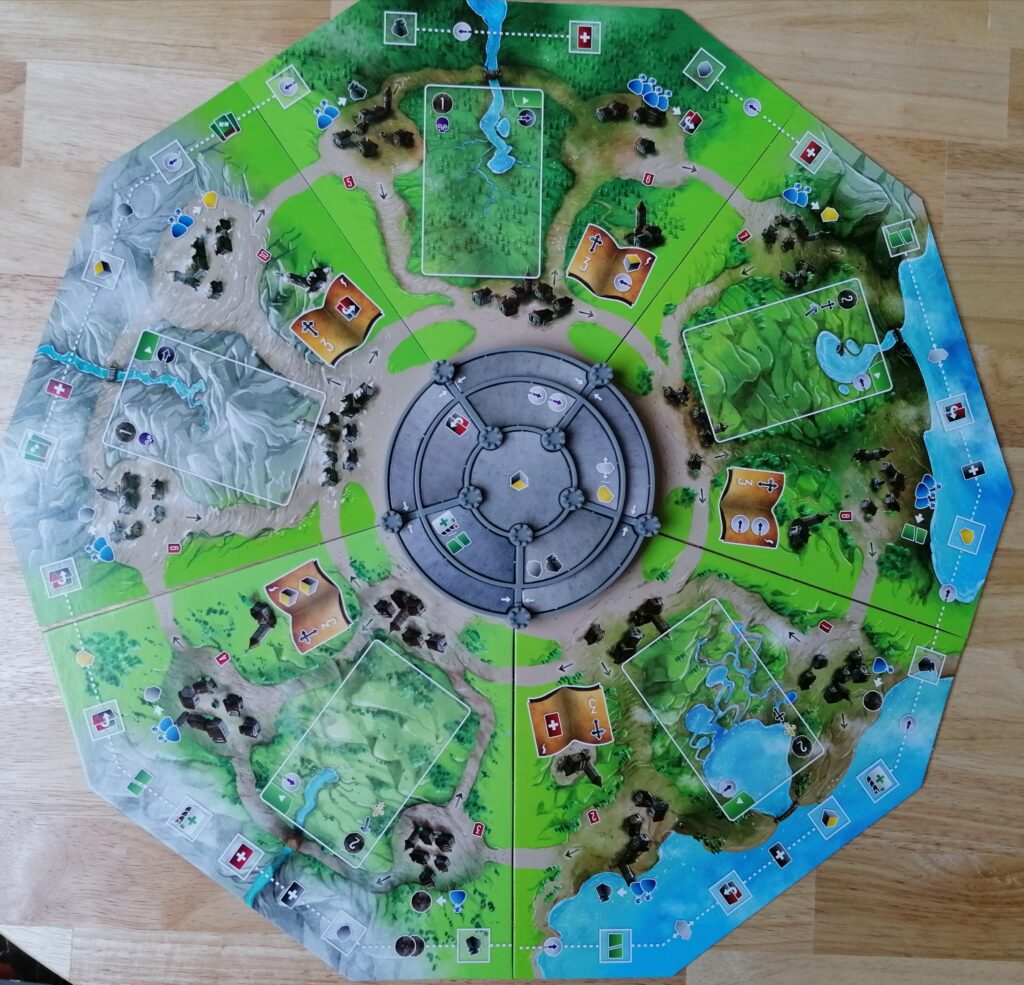
Movement on the main board is a fairly important decision in itself. You can only perform two of the four actions available in each space. If your piece is positioned on the outside of the board, then you can only perform the build (hammer symbol) and trade (bag symbol) actions. If you are on the inside, you can only perform the transcribing (cross symbol) and castle (fleur-de-lys symbol) actions. You can increase the distance you move by paying one coin for each extra space, so you’re not restricted so much that you’ll have to settle for an action you don’t necessarily want to take, but you’ll need to make sure you have coins available. The trade action is a way to gain more, as well as any of the other resources, and coins are the easiest to gain, as when you are on the correct spot, you will only need to spend one trade action point to gain one card, whereas you’ll need to spend more to gain the others. As with the movement, you can exchange coins for extra trade action points.
You can build in any available space at the very edge of the board, and you can build any building from your player board that you can afford, the cheapest costing three action points and the most expensive costing seven. You can also spend stone to gain more build action points. The benefits of building are that you gain an immediate bonus depending on where you place it on the main board, an ongoing benefit based on the symbol you reveal when removing the building from your player board, and points at the end of the game, based on how many of the different types of buildings you have placed.
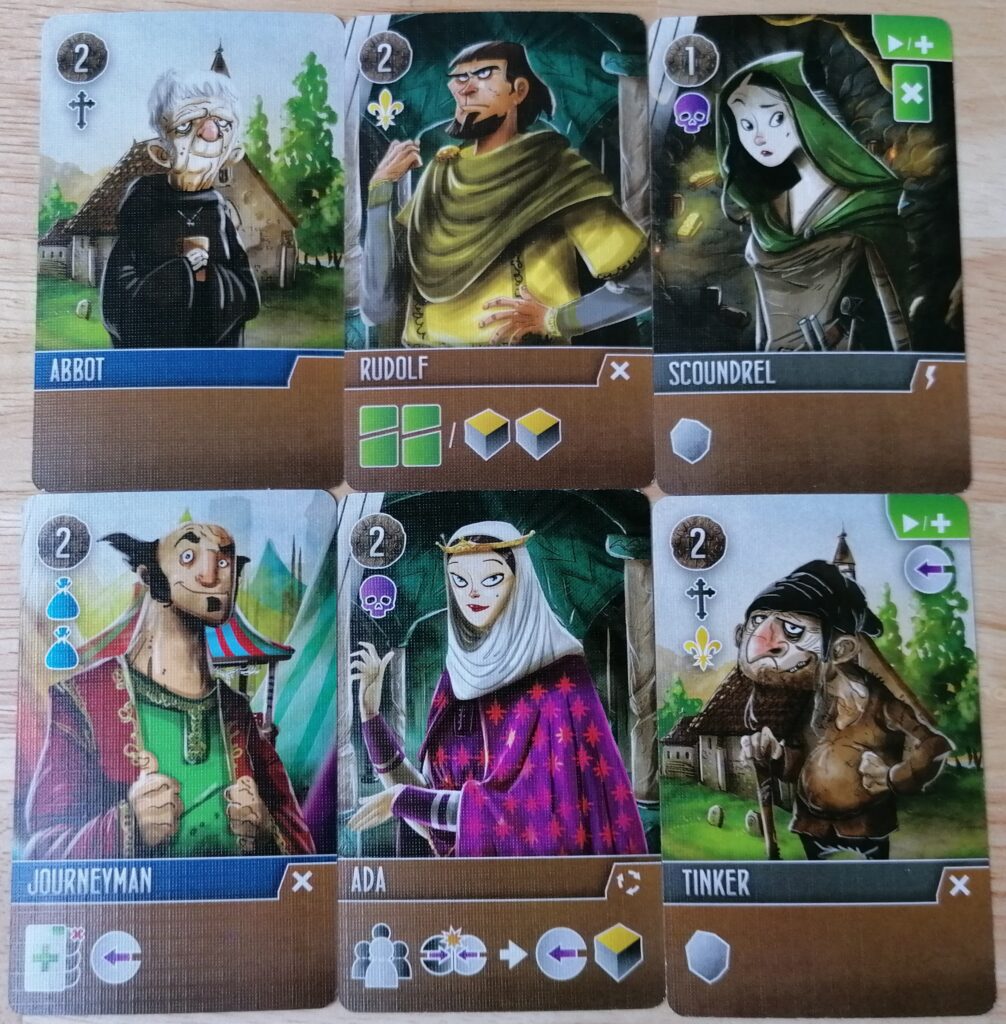
Transcribing allows you to spend a certain amount of these action points to take the top face-up token in your section of the board. You can increase the amount of these action points you have by spending inkwells, and you’ll gain an immediate or end game bonus. You’ll also be working towards set collection, as if you collect three of the same colour, you’ll take a card which gives you three points at the end of the game. Also, you will gain more points based on how many sets of different colours you have.
The castle action is probably the most complex in Viscounts of the West Kingdom, but only because there are potentially multiple steps to it. Which section of the board you are in will determine where in the 3d castle you can place your workers, and you will spend one, three, five or eight action points to place one, two, three or four workers in that section of the castle (you can pay gold to increase the number of action points you have). You place all the workers in the section furthest from the centre (first tier) initially. Then, you will check to see if there are three or more of your own workers in that section. If there are, you’ll move one worker to the section to the left, one to the right, and a third worker one step closer to the centre (second tier), immediately resolving the effect printed on the tile this worker moved up to. As you get further into the game, you may have to repeat this process one or more times, depending on how many workers you have in the various sections of the castle. After this is done, you’ll check the second tier in the same way. If there are three or more of your workers in a section, you’ll move one into the centre of the castle, but you won’t move any to the left or right this time.
Once you have done all of this, you will check to see if there are any sections in the first or second tiers with more than three workers of any colour. If there are, you’ll remove as many workers as needed until there are a maximum of three in the first or second tiers, returning these workers to their respective players. For each of a player’s workers returned to them, they receive a bonus, based on whether they were removed from the first or second tier. As I said, the castle action sounds complex, and there are quite a few steps to get used to, but like with everything else in this game, once you’ve played for a little bit, it’ll become second nature to you.

The tracks from the first two games are replaced in Viscounts of the West Kingdom by the collision track. On your player board, you have a white token (virtue) at one end of this track, and a black token (corruption) at the other end. At various points in the game, you will be told to move one or both of these to the left or right, and if these two ever meet before you reach the part of your turn when you resolve a collision, and need to move again, then they move together. When you resolve a collision, you’ll look at where these tokens ended up, and your player board state, and gain resources accordingly. This is another intriguing part of the game for me, adding to the already rich puzzle present, with every option seeming viable depending on the game state.
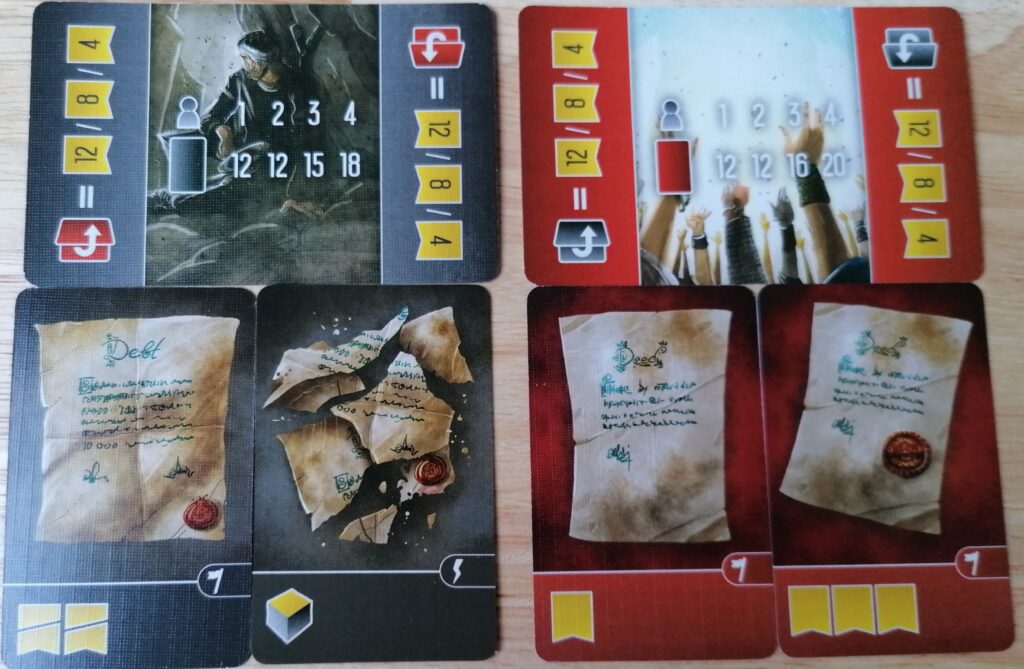
Another common element throughout this trilogy is the idea of debt, and here, it’s represented in the most different, and for me, best way. There are now deed cards (red) as well as debt cards. Depending on player count, you’ll place a certain amount of these cards on top of the ‘poverty’ (black) and ‘prosperity’ (red) cards which show the amounts and some points. The end of the game triggers when at least one pile is emptied, revealing the relevant card, and at the end of the game, if the poverty card is revealed, extra points go to the players with the most deed cards, and vice versa. This is an excellent way to balance the game, as you may have taken a huge amount of deed cards to end the game, but your opponents, who may have seen this and gone for debt cards instead, will now receive extra points.
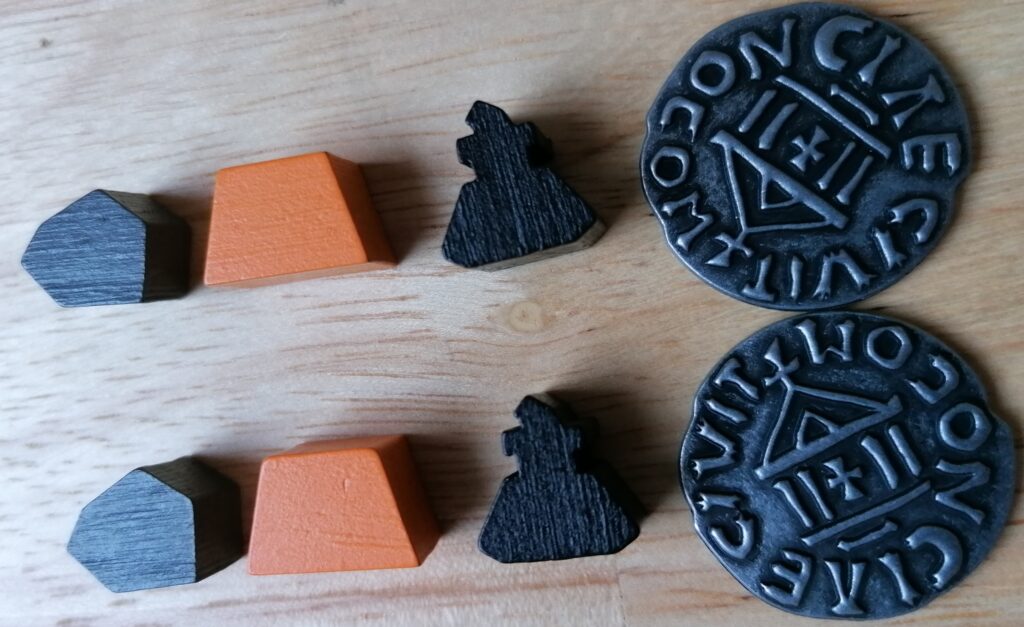
Production, as with the previous two games, is very good in this game, from the individually shaped and coloured resources (as opposed to cubes) to the familiar-looking workers and the well-crafted player piece. As my copy was bought through Kickstarter, I received metal coins, which are very nice, though a slight downside is that the gold resources came out looking more orange than they should.
All three games in this trilogy, I would say, are very different games, and therefore difficult to compare. I would put the complexity of Viscounts of the West Kingdom closer to the second game than the first, though still less so. If I were to want a game to introduce to relatively new players, I would choose the first in the series, but for depth and crunchiness, I would go for either of the others. If I had to rank them, I would probably put this game just above the second for the top spot, though that could easily fluctuate. Overall, this whole trilogy is excellent, and I’m so happy to own all three.
| Prices delivered by BoardGamePrices | |
|---|---|
 | Viscounts of the West Kingdom £38.76 with shipping, in stock! Buy now See all 36 offers! |

